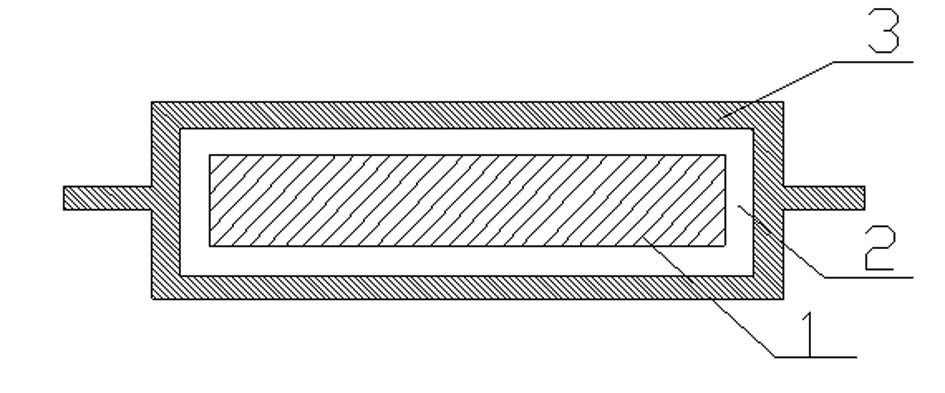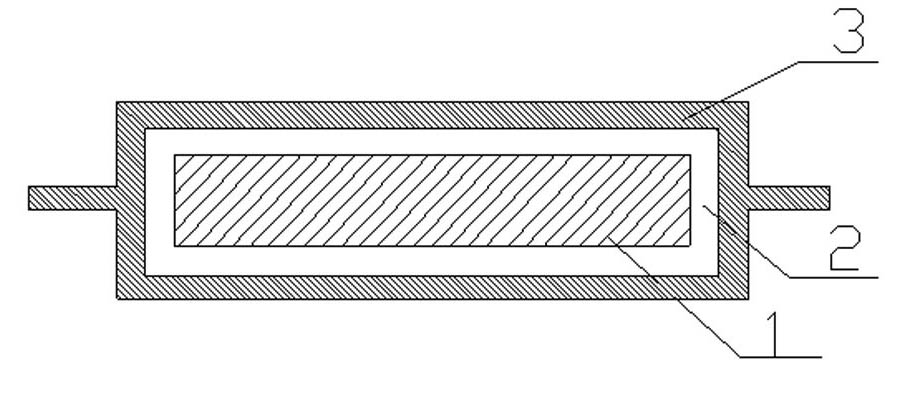Vacuum insulated panel produced from superfine glass wool with wet process and method for producing same
A wet superfine, glass vacuum technology, applied in glass/slag layered products, chemical instruments and methods, layered products, etc., can solve the problems of poor flame retardancy of PU, and achieve high stability, good elasticity, and economical energy effect
- Summary
- Abstract
- Description
- Claims
- Application Information
AI Technical Summary
Problems solved by technology
Method used
Image
Examples
Embodiment 1
[0027] As shown in the figure, a wet-process ultrafine glass wool vacuum insulation panel includes: a core material 1, a gas adsorption material layer 2, and a barrier film layer 3; the core material 1 is located in the innermost layer, and the gas adsorption material layer 2 Wrapped on the outer surface of the core material 1, the barrier film layer 3 is wrapped on the outside of the gas adsorption material layer 2; the core material 1 is an ultrafine glass wool core board.
[0028] The production method of the above-mentioned wet process superfine glass wool vacuum insulation panel, its concrete steps are as follows:
[0029] (1) Prepare waste glass and clean it;
[0030] (2) Mixing formula: Mix 100 parts of waste glass with SiO 2 Silica 65.00 parts, B 2 o 3 Boron oxide 4.00 parts, AI 2 o 3 Aluminum oxide 1.97 parts, Fe 2 o 3 0.41 parts of iron oxide, 7.5 parts of CaO calcium oxide, 30.20 parts of MgO magnesium oxide, Na 2 Sodium Oxide 15.11 parts, K 2 0.51 part of ...
Embodiment 2
[0040] The structure and production method of the wet-process ultra-fine glass wool vacuum insulation panel in this example are the same as those in Example 1, except that the mixing formula in step (2) of the production method is different. According to customer needs, the mixing formula is as follows:
[0041] 100 parts of waste glass and SiO 2 Silica 66.45 parts, B 2 o 3 Boron oxide 4.08 parts, AI 2 o 3 2.5 parts of alumina, Fe 2 o 3 0.50 parts of iron oxide, 7.66 parts of CaO calcium oxide, 30.34 parts of MgO magnesium oxide, Na 2 Sodium Oxide 15.50 parts, K 2 0.50 part of potassium oxide was mixed to obtain a mixture.
Embodiment 3
[0043] The structure and production method of the wet-process ultra-fine glass wool vacuum insulation panel in this example are the same as those in Example 1, except that the mixing formula in step (2) of the production method is different. According to customer needs, the mixing formula is as follows:
[0044] 100 parts of waste glass and SiO 2Silica 67.00 parts, B 2 o 3 Boron oxide 5.00 parts, AI 2 o 3 Aluminum oxide 1.80 parts, Fe 2 o 3 0.35 parts of iron oxide, 8.00 parts of CaO calcium oxide, 30.50 parts of MgO magnesium oxide, Na 2 Sodium Oxide 15.00 parts, K 2 0.60 part of potassium oxide was mixed to obtain a mixture.
PUM
| Property | Measurement | Unit |
|---|---|---|
| density | aaaaa | aaaaa |
| thickness | aaaaa | aaaaa |
Abstract
Description
Claims
Application Information
 Login to View More
Login to View More - R&D
- Intellectual Property
- Life Sciences
- Materials
- Tech Scout
- Unparalleled Data Quality
- Higher Quality Content
- 60% Fewer Hallucinations
Browse by: Latest US Patents, China's latest patents, Technical Efficacy Thesaurus, Application Domain, Technology Topic, Popular Technical Reports.
© 2025 PatSnap. All rights reserved.Legal|Privacy policy|Modern Slavery Act Transparency Statement|Sitemap|About US| Contact US: help@patsnap.com


